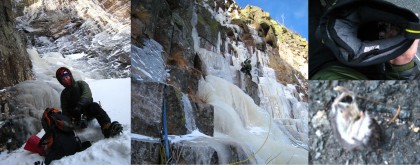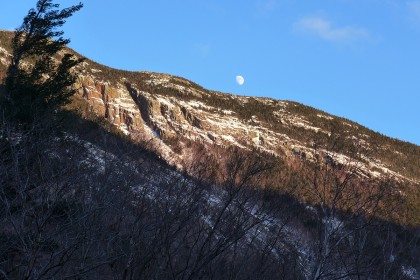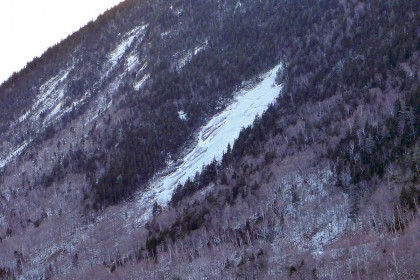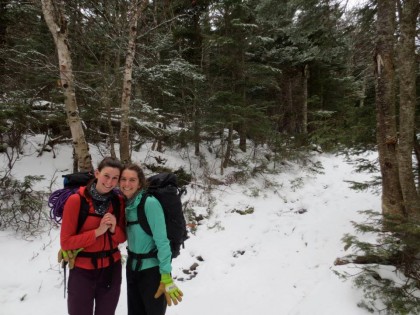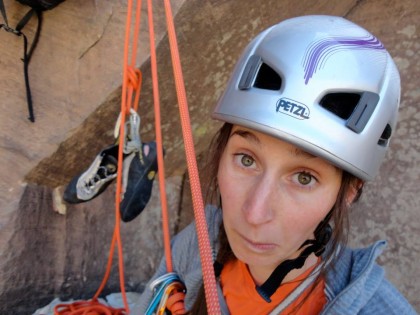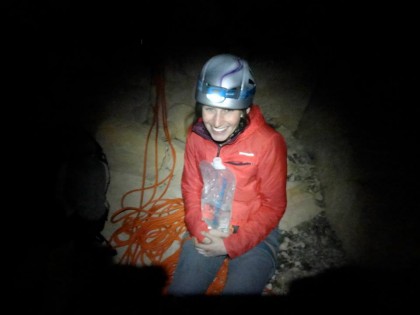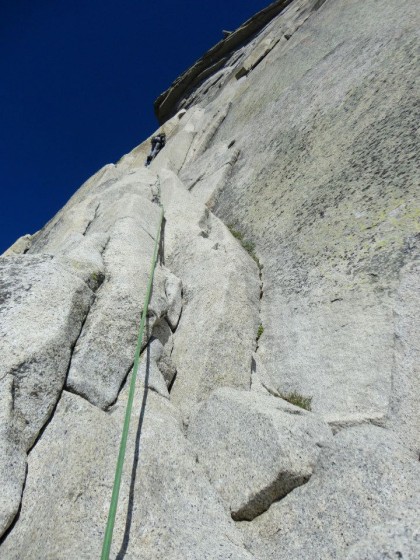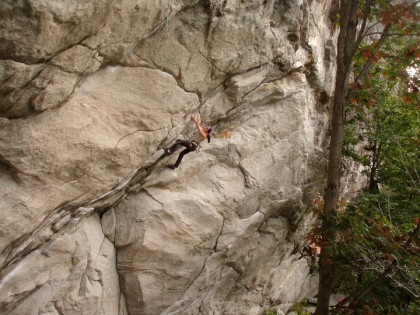Get Your S$%t Together!
Ice Climbing Is More Fun When You Are a Little Bit Obsessive
By CMG Guide Janet Wilkinson
Cannon Cliff, Winter 2008ish. As Freddie took off up the second pitch of Fafnir, he complained for the second or third time about his left foot being cold. He placed a piece, stopped momentarily to swing and shake it out, and I remember thinking it odd, since I am always the one who gets cold. We finished the route and walked down the descent trail to our car. Sitting on the passenger seat, he pulled his cotton-sock-clad foot out of his boot, turned the boot upside down and shook it, and out slid a gray mass of fur. ‘Oh my god’, he said, picking it up for me to see. It was a squashed mouse corpse, and it had just gotten a free ride up, and then down, Cannon Cliff.
This is the guy I have been with for 11 years now: He sometimes wears cotton tube socks winter climbing and he hardly notices when a dead mouse is in the bottom of his boot on a hard mixed route. He sharpens his picks only a few times per season and regularly climbs on beat up ropes with no sign of dry treatment left on them, despite being sponsored by a rope company. And he slays the winter climbing.
Granted, that was years ago, when we were living in a tiny cabin and it was hard to be organized, and even harder to keep mice out of things since our climbing gear was kept in a shed. But Freddie’s style has rubbed off on me over the years, encouraged by my relaxed personality. The problem is that I don’t slay the winter climbing like he does. I often have a mind block about the whole ‘not falling’ thing, I get cold, and I generally have to have a lot of things go well to actually have fun.
It turns out other people don’t climb with dead mice in their boots. I have one friend who won’t even let me bring my rope or screws when we climb, preferring to use her own more reliably sharp and dry versions. So I decided last winter that I will start to care more, and because of it I might have more fun more often. A dry treated rope, sharp metal, and good socks are a great starting point. Here are a few other tips to help you look good, feel comfortable, and stay safe out there, so you can concentrate on having more fun:
- Do some preseason heel raises. I do them with a 25 lb weight on the edge of a step a few days a week starting in November to get ahead of the long, cold front pointing season.
- Keep a list of what you like to pack. I have a list of mountain rescue gear hanging next to my closet so when the call comes and things are hurried, I know what I need. Include an adequate first aid and repair kit. Marc Chauvin’s repair kit for a Mount Washington day is a spare middle bar and bail wire to fix a crampon, and a wrench in case a pick loosens. You might also add a spare pick, some duct tape, and a zip tie or two. A first aid kit ranges from just a roll of cloth tape to the full caboodle.
- Ladies, if you are smaller than the average ice climber (most winter climbing gear seems to be built for 175+ lb males), take the time to customize your stuff. I cut a few inches off the middle bar of my crampons, and hot knife a few inches off the straps too, along with cutting extra webbing from belts and back pack straps. If you are just getting into ice climbing, do not, I repeat do NOT let your boyfriend convince you to use his old leashed Cobras and G14s from 1999. Unless of course bashing your knuckles to smithereens while swinging concrete blocks on your feet sounds like fun to you. Ice gear has evolved drastically in the last 10 years, it is worth finding while you learn to climb.
- I used to pack a liter of plain water and a liter of hot tea in a thermos for a day out. I almost never drank the water, so now I usually just bring tea, knowing I can add snow to increase volume if I get extra thirsty. I pre-hydrate by limiting coffee and drinking a huge to-go mug of decaf tea en route. Bring food that will still be appetizing if it freezes. Especially NOT appetizing frozen ingredients include egg and apple. Peanut butter and honey sandwiches are a personal favorite.
- The clothing system matters. I tuck my base layer top into my base layer pants, then mid layer tucked into my softshell or insulated pants with a shell jacket over it all. The harness carries a lot of weight so keeping those layers smoothly interlaced keeps it from digging in. (Ladies, this will all go to hell if you have to pee with your harness on so pee before you start a climb and/or get one of those handy pee-standing-up devices.) I feel goofy in tight fitting hats, so I wear a looser one for the approach and then have a tighter one for under the helmet. It’s not cool or safe to have the helmet list to the side or when the too-big hat slips down over your eyes. Four pairs of gloves at the minimum: one for the sweaty approach, one for belaying/rappelling, and save the lead gloves for just that: leading. Take the time to find lead gloves that you love, and bring two+ pairs. When you find good lead gloves, treat them like gold (ie don’t rap or belay in them). Put your climbing socks on when you put your boots on. Dry, fresh socks = happy feet. I approach with absurdly loose boots and tighten them up only when I put crampons on. My feet are more comfortable and warm when they are loose in the boot.
- Make sure your backpack fits well over your harness and that you are able to look up while climbing with it on. I replace the metal pack frame with a foam pad to help this issue, and it handily doubles as a sleeping/sitting pad or a splint for first aid. Keep gloves and hats in a separate stuff sack in your pack so your gear doesn’t blow/roll away as you unpack. Keep another stuff sack for your belay parka in its pocket so you can hang it from your harness on multipitch climbs.
- Know where you are going and how to deal if things go bad. Practice your v-threads, consider how you could repair anything that might break, consider that your phone might freeze or be out of range, know how to escape a belay.
- I used to treat the end of an ice climbing day like the end of a rock climbing day and strip off my harness with everything still attached to it and throw it in my pack. After a few dinged up ice screws and a few holes in my pack, I now put the rubber caps back on the screws at the end of the day and put them in their own little vinyl bag. Carefully wrap the crampons with points facing each other if you don’t use a crampon pouch. Do this every time. Same deal when you get home from climbing: Unpack and dry your stuff out the minute you get home. No snuggling your puppy or opening a beer until it’s done. Dry gear is happy gear, and who knows, maybe you’ll go out again tomorrow!
Ladies, come share your favorite tricks for making winter climbing fun, and learn a few more to add to your mix at an upcoming Ladies Only Winter Climbing Workshop!
(I should acknowledge here that, joking aside, Freddie’s seeming indifference about foot care and his ability to crank with dull tools and crampons is certainly eclipsed by his love of a well organized gear closet and his seemingly innate capacity to deal with just about any situation that arises out there in the cold.)

